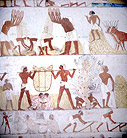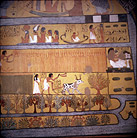Self-identity Relative to other Egyptians
Nevertheless, within the basically unitary culture individual differences/identities played an important role. These distinctions/identities were based on a whole range of traits, some changing, some fairly stable. Age was one aspect of self-identity. There are texts that differentiate between children, people of an age to be liable for military or expeditionary service, and people who have finished such service and married and begun families. Male circumcision seems to have been done in groups as young men reached the age of "maturity." The clothing a person wore could reflect such age distinctions. Children wore the "sidelock of youth" and, when quite young, would be shown naked. Hairstyles, or wig styles, also could indicate whether a person was of marriageable age or was married. Clothing could also indicate status. Old age was a recognizable category, and the elderly were to be respected (the ideal appears to have been to live to 110). Nevertheless, some depictions of elderly individuals reflect the wear and tear that age has wrought.
Gender roles were distinct, at least among the elites. All people were expected to marry and have a family. Women ran the home and raised the children; the only outside job such a woman might have was as a musician associated with a temple. Elite men, however, had jobs outside the home, serving in government, the temples, and so on.
This distinction in gender roles is also reflected in Egyptian art: women are shown as having yellow skin, presumably because they stay inside and out of the sun, while men are shown as having red skin, presumably because they are outside and subject to tanning. One element of self-identity came with occupation, which provided or reflected one's status. Since both government and temples were organized hierarchically, age, length of service, and rank to which a man had risen were all part of his status and self-identity. Such status, and self-identity, spread from the man to his wife; a wisdom text notes, "A woman is asked about her husband, a man is asked about his rank/profession/office." Since professions and jobs were frequently handed down through families, one's kin were also part of one's identity.
We don't know much about the self-identity of the majority of Egyptians who were farmers living not in cities but in small towns near their land. Were gender roles relaxed so that the women could be expected to help with the farm work? Is that implied by tomb scenes showing husband and wife together plowing in the Egyptian equivalent of the Elysian Fields? Certainly among non-elites some women had jobs outside the home because many women are depicted as servants in the wealthy homes of the elite; there are also many references to women weaving and selling their goods to make (extra) money.
Egyptian society was polytheistic. Some deities were mainly local deities revered in one area of the country; others, especially those associated with kingship, were worshipped throughout the country. Egyptian religion was not exclusive, and individuals would turn to different deities for different needs. Many individuals, especially from the New Kingdom "age of personal piety," would frequently feel a particular attachment to one particular deity, which would form an important aspect of their self-identity. The Greek writer Herodotus commented on the peculiar Egyptian fascination with animal cults, so for him, at least, part of Egyptian identity was acceptance of such cults.

 Janet H. Johnson
Janet H. Johnson
Morton D. Hull Distinguished Service Professor of Egyptology
Guiding Questions
1. How did ancient Egyptians maintain a sense of self-identity in their unitary society?
2. Why do you think elite Egyptians maintained distinct gender roles while for the more common people this line was blurred?
3. Discuss how, over time, foreigners blended in with Egyptian society. Identify modern unitary societies that have assimilated foreigners and compare their assimilation strategies.


 Print Page
Print Page





